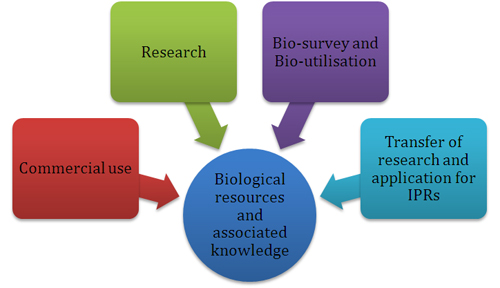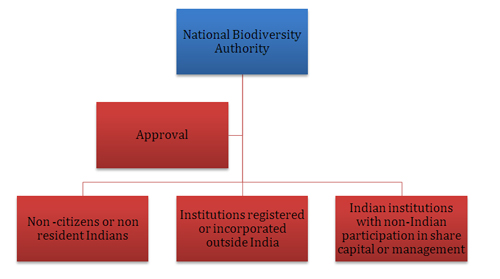The Biological Diversity Act 2002
What is covered by the Biological Diversity Act?
The Act covers conservation, use of biological resources and associated knowledge occurring in India for commercial or research purposes or for the purposes of bio-survey and bio-utilisation. It provides a framework for access to biological resources and sharing the benefits arising out of such access and use. The Act also includes in its ambit the transfer of research results and application for intellectual property rights (IPRs) relating to Indian biological resources.


Who is covered by the Biological Diversity Act and what do they require?
The Act covers foreigners, non-resident Indians, body corporate, association or organization that is either not incorporated in India or incorporated in India with non-Indian participation in its share capital or management. These individuals or entities require the approval of the National Biodiversity Authority when they use biological resources and associated knowledge occurring in India for commercial or research purposes or for the purposes of bio-survey or bio-utilisation.
Indians and Indian institutions do not require the approval of the National Biodiversity Authority when they engage in the above mentioned activities. However they would need to inform the State Biodiversity Boards prior to undertaking such activities. However, any commercial application related to use of biological resources should be approved by the Authority.

Who and what is excluded by the Biological Diversity Act?
The Act excludes Indian biological resources that are normally traded as commodities. Such exemption holds only so far the biological resources are used as commodities and for no other purpose. The Act also excludes traditional uses of Indian biological resources and associated knowledge and when they are used in collaborative research projects between Indian and foreign institutions with the approval of the central government.

What is the National Biodiversity Authority required to do when it receives an application for approval to use Indian biological resources and associated knowledge?
The National Biodiversity Authority shall give approval, based on agreement with State Biodiversity Boards (SBBs), only after establishing mutually agreed terms and an equitable benefit sharing agreement between the users of the biological resources and associated knowledge and concerned local bodies and benefit claimers.
What are the consequences of lack of compliance with the Biological Diversity Act?
In cases where an approval of the National Biodiversity Authority is required for the use of Indian biological resources and associated knowledge and such approval is not obtained, the punishment can extend to five years imprisonment or a fine of ten lakh rupees or both.
In cases where the State Biodiversity Board needs to be intimated about the use of Indian biological resources and associated knowledge and this is not done, the punishment can extent to three years imprisonment or a fine of five lakh rupees or both.
Any offence under the Act is cognizable and non-bailable.
Relevant definitions for the purposes of the Biological Diversity Act:
Biological resources: means plants, animals, microorganisms, genetic material and by-products of value but excluding human genetic material.
Bio-survey and bio-utilization: means survey or collection of species, sub-species, genes, components and extracts of biological resources for any purpose including for characterisation, inventories and bioassay.
Benefit claimers: means conservers of biological resources and their by-products and creators and holders of knowledge relating to the use of such biological resources.
Commercial utilization: means using biological resources as drugs, industrial enzymes, food flavours, fragrances, cosmetics, emulsifiers, oleoresins, colours, extracts and genes used for improving crops and livestock through genetic intervention.
---------------------------------------------------------------------
---------------------------------------------------------------------
Centre for Biodiversity Policy and Law
National Biodiversity Authority (NBA) has proposed to start a Centre for Biodiversity Policy and Law (CEBPOL) to deal with emerging and current biodiversity governance and policy related issues. The Government of Norway and India decided to collaborate and a letter of intent for technical and institutional cooperation was signed on 19th November, 2010 by between Mr. Erik Solheim, Norwegian Minister of Environment and Development and Mr. Jairam Ramesh in New Delhi.
-----------------------------------------------------------------------
Biodiversity encompasses the variety of all life on earth. India is one of the 17 mega biodiversity countries of the world. With only 2.5% of the land area, India accounts for 7.8% of the recorded species of the world. Biodiversity in India is mainly recognized at three levels, namely species levels, genetic level and ecosystem level. Biogeographically, India is situated at the tri-junction of the Afro-tropical, the Indo-Malayan and the Palearctic realms. Because of its proximity to all the three realms, India possesses a unique assemblage of characteristic elements of biodiversity of each of them.
1.2 According to surveys conducted so far, 45,500 species of plants and 91,200 species of animals are found in India. India is an acknowledged centre of rich crop diversity. India is considered to be the home of 167 important cultivated plant species and 320 species of their wild relatives. India is considered to be the center of the origin of several varieties of rice, pigeon pea, mango, turmeric, ginger, pepper, banana, bitter gourd, okra, coconut, cardamom, jackfruit, sugarcane, bamboo, taro, indigo, sunhemp, amaranths, goose berries etc. India’s domesticated animal wealth consists of diverse livestock including fish, poultry, animal breeds etc. Unless this biodiversity is used sustainably, the future generation of India may be deprived of its benefits for food, nutritional, household, health and environmental security. 1.3 The country has contributed to and is party to key multilateral agreements on environmental issues, including the Convention on Biological Diversity (CBD). Pursuant to the CBD, following a widespread consultative process, and programs related to biodiversity, Biological Diversity Act, 2002 has been enacted. This Act was promulgated on the 2nd of December 2002. India is one of the few countries to have enacted such a legislation. This Act primarily aims at giving effect for conservation and sustainable use of biodiversity and facilitate access to biological resources and associated traditional knowledge so as to ensure fair and equitable sharing of benefits arising out of their commercialization. The Govt. of India promulgated the Biological Diversity Rules in 2004. 1.4 The different provisions of Act are being implemented by the National Biodiversity Authority (NBA) established in 2003. The NBA takes measures to protect the biological diversity of the country as well as oppose the misappropriation of Indian bioresources and /or the associated knowledge. The NBA performs functions such as laying down the procedures and guidelines to implement various provisions of the Act. The authority coordinates the activities of the State Biodiversity Boards and Biodiversity Management Committees by providing the needed technical assistance and guidance, as well as commissions studies and sponsors special initiatives. 1.5 In order to implement different programmes, need for strengthening of institutional structures has been recognized as a critical element. Hence a project “ Strenghtening Institutional Structures to Implement the Biological Diversity Act” was conceived and developed and is being implemented by MoEF, NBA and UNDP. 1.6 The programme also draws from the lessons learnt from the UNDP environmental projects in the Country Cooperation Framework II phase (2002-2007) that highlight the need for impact oriented, focused and integrated approaches with strong institutional structures to ensure sustainability of UNDP’s intervention. 1.7 The main focus is to strengthen the institutional capacities at various levels and of different stakeholders in UN Development Assistance Framework (UNDAF) states and bring in behavioral changes to manage natural resources in an integrated, participatory and sustainable manner. Owing to the close link between the Biological Diversity Act 2002, NEP 2006, Schedule Tribes and other Traditional Dwellers (Recognition of Forest Rights) Act 2006, National Biodiversity Action Plan 2008 and India’s Fourth National Report to the CBD, inclusion of natural resource dependent tribal and marginalized population, particularly women, in the planning and decision making process is one of the critical and vital elements of the strategy. In view of importance of biodiversity in overall natural resource conservation scenario, the project becomes critically important initiative. The project will be operationalised with the National Biodiversity Authority as the key responsible partner in close partnership with the Ministry of Environment and Forests (MoEF). The proposed intervention will focus mainly in Jharkhand and Madhya Pradesh states with rich biodiversity and globally significant species. The project will help to address the challenges in implementation of the Biological Diversity Act by supporting strengthening the SBB and BMC through capacity building, awareness and education and database and networking. The initiatives in the two states are pilots that will function as templates in strengthening the Biodiversity Boards of India. 1.8 Madhya Pradesh is among the few states with a fully functioning SBB and BMCs. Experiences and lessons learnt from Madhya Pradesh in setting up SBB and BMCs will be shared with Jharkhand and other UNDAF states with limited institutional structure and capacity. The primary focus of the project is to strengthen the capacity of institutions that are directly involved in the implementation of the Biological Diversity Act at all levels, such as the BMCs, SBBs and the NBA. The project also envisages developing the capacity of relevant academic and government institutions, including rural development, forest department, municipalities and Gram Panchayats. 1.9 Specifically, the project will help strengthen existing capacity to monitor natural resources in select districts of Madhya Pradesh where the BMCs exist, analyze their impact and document the traditional conservation practises. The project will facilitate establishment of BMCs in select districts of Jharkhand – because of their biodiversity significance and domination of natural resource dependent tribal communities – through capacity building of Gram Panchayats.The main activities will include documentation of bio-resources, site visits, training and awareness campaigns on a continued basis, and exchange of information with states having operational biodiversity boards. The project will support the BMCs in creating and maintaining the People’s Biodiversity Registers (PBRs). A replicable model of PBR will be developed in accordance with the model prepared by National Biodiversity Authority. Strengthening the capacity and skills of the SBBs and BMCs to identify areas of biodiversity importance to be declared as heritage sites will also be a part of the capacity building. |

No comments:
Post a Comment